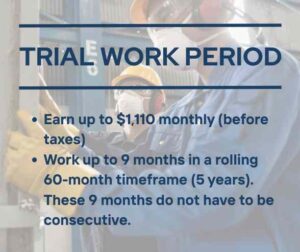What Is the SSA’s Trial Work Period — and How Can It Help?
Returning to work after a disability can feel like stepping into the unknown. You might be excited, nervous, or unsure about how working could impact your Social Security Disability (SSD) benefits. That’s where the Trial Work Period (TWP) from the Social Security Administration (SSA) comes in.
What Is the Trial Work Period?

The TWP is a safety net that allows people receiving SSD benefits to test their ability to work without immediately losing their benefits. Think of it as a “test drive” for employment. During the TWP, you can earn income by working for up to 9 months (not necessarily in a row), and still receive your full SSD benefits no matter how much you earn.
How Long Does the TWP Last?

You are allowed 9 trial work months within a rolling 60-month (5-year) window. Once you use up those 9 months, you move into a new phase of the SSA’s return-to-work programs. It is essential to know that the “test drive” months do not have to be consecutive. If you work one month, stop for a while, and return to work again, each work month still counts toward your 9-month limit. It is imperative to let your legal representative know if you plan to try to work again, when you start, if you stop early, and the reason why.
What Counts as a “Trial Work Month”?
A month counts as a trial work month if your gross earnings exceed a certain threshold. Currently, that threshold is $1,110 per month.
If you are self-employed? The rules are a bit different. A month can count if you:
- Work more than 80 hours in your business, or
- Earn more than the monthly threshold
Why Is A TWP Important?
The TWP gives you the freedom to explore working again without fear. It is meant to support people who want to try returning to work but are not sure if they can sustain it long-term due to their medical condition. This way, you are not punished for trying.
What Happens After the TWP Ends?
Once your 9-month TWP is over, you enter the Extended Period of Eligibility (EPE), which lasts 36 months. During the EPE, you can still receive benefits for any month your earnings fall below the Substantial Gainful Activity (SGA) level. The SGA level is higher than the TWP threshold. Currently, the SGA is $1,550/ or $2,590 if you are blind. This is highly beneficial so that you are not left without support even after your trial ends.
Can You Use the TWP Again?
Usually, no. Once you have completed your TWP, you don’t get another one unless you:
- Are no longer receiving SSD benefits
- Have a new period of disability
- Complete a new application and are approved again
This can become confusing and require some record-keeping. Of course, the SSA keeps track, but it is wise to keep your own records: how many trial months you have used, your earnings, etc.
If unsure where you stand, you can contact the SSA or check your mySocialSecurity account online. (Click here for more information on this).
The TWP program is beneficial for many reasons and for many people. However, it does require diligence and being detail-oriented to keep track of everything and ensure you do not misuse any of your TWP months. If you have questions about the TWP program, you can always contact your legal representative, and they can answer your questions.
 If you have questions about social security or veteran affairs disability or wish to begin a claim, contact the legal team of Parmele Disability Advocates. You can schedule your no-cost consultation by calling 866-889-2570.
If you have questions about social security or veteran affairs disability or wish to begin a claim, contact the legal team of Parmele Disability Advocates. You can schedule your no-cost consultation by calling 866-889-2570.
Parmele Disability Advocates. Disability advocacy for all.
